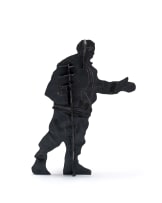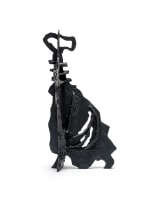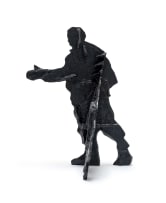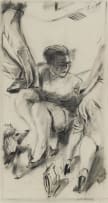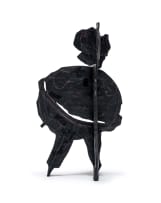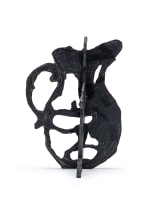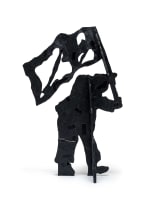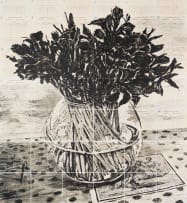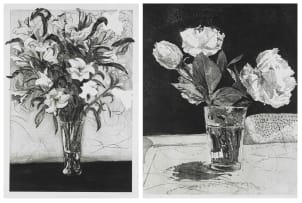Shadow Figure I
William Kentridge
About this Item
signed, dated 2016, numbered PP 1/1 and inscribed with the title on the accompanying certificate of authenticity
Notes
Shadow figures are ubiquitous in the work of William Kentridge. Most notable examples are the monumental procession of shadow figures telling the history of Rome on the 550 metre banked wall on the Tiber River in Rome, called Triumphs and Laments (2015); the massive video installation of More Sweetly Plays the Dance at Zeitz MoCAA, Cape Town (2015); the magisterial procession in the theatre production, The Head and The Load (2018); and more recently, the title of a major retrospective exhibition at The Broad in Los Angels, titled, In Praise of Shadows (2022).
Kentridge's sculptural figures add another conundrum to the concept of shadow, the first of course, famously, Plato's shadows-in-the-cave, suggesting that we only see ever the bare outlines of history, never the full story: the whimsical, puzzling nature of reality, in other words. Kentridge's conundrum relates to the nature of substance: shadows are supposed to be insubstantial, two-dimensional, ephemeral, and fleeting, but his shadow figures are substantial three-dimensional bronzes, albeit immovable shadows. Kentridge's often deals with the 'shadows of the past' so to speak, thereby adding a socio-political and historical dimension to his sculptures.
Immovability, however, is yet another illusion: revolve Shadow Figure I, and the figure of a man turns into that of a woman; revolve Shadow Figure II, and a compass morphs into a man carrying scales. Shadow Figure III is of a jug transforming into a seated figure, and Shadow Figure IV of a pylon becoming a man waving a flag.
The origin of these magnificent shadow figure bronzes resides in the conceptualization of the stage production Kentridge developed for Alban Berg's opera, Lulu. Lulu, based on a character created by the playwright Frank Wedekind, is the universally desired woman, but, in his play, an overwhelming sexual desire, no less. Each of Lulu's suitors (the four males of Shadow Figures) looks for something else in her as well as something that fills a void in their own characters. Each is to be disappointed, and ultimately annihilated, when he discovers the illusionary nature of his goal. The Shadow Figures are these illusions.
The production of Lulu (2015) led to Right Into Her Arms (2016), a kinetic sculpture theatre miniature in which the moving elements of the set become the protagonists of the love story. Right Into Her Arms, the title of an exhibition at the Annadale Galleries in Sydney in 2016, showed the model miniature theatre installation, together with charcoal drawings, woodcuts, etchings, and these four Shadow Figures for the first time.
The notion of scale is important to Kentridge: he prefers a 1:11 ratio for his models, unlike the usual 1:20 scale used by other set designers, the reason being that he can literally insert himself in a set of this scale to get maximum viewpoints of the overall effect. The miniature model is then upscaled to the original size of objects in the actual production. Says Kentridge: 'Elements of the model for the set are often made from papers and objects from around the studio - pages from books, pieces of sandpaper, or the base of a coffee pot standing in for a table. These are then enlarged by set builders and scenic painters to the size of the real stage, so a page of a book thirty by twenty two centimetres becomes a painted canvas of two metres by one metre fifty. The twenty-five-centimetre coffee pot becomes a full-sized table.'1
The notion of sculpture in Kentridge's artistic oeuvre is also significant. Says he: 'The images themselves would never have arrived if I was simply thinking about sculpture. Having been pushed into existence by demands outside of the form of sculpture, they became interesting for me as sculptures in themselves, when their point of origin was lost. They shift between stage props and temporary sculptures when they come offstage and are exhibited.' (2) Kentridge certainly opens a new world with his four Shadow Figure sculptures that is equally challenging and beguiling to the viewer.
1 Karel Nel & Owen Martin (2019) Why Should I Hesitate: Sculptures.
Norval Foundation, page 180.
2 Ibid, page 283.
Exhibited
Annandale Galleries, Sydney, William Kentridge: Right Into Her Arms, 2 October to 8 December 2018, another cast exhibited.
Literature
Annandale Galleries, Sydney, William Kentridge: Right Into Her Arms, 2 October to 8 December 2018, another cast illustrated in colour on pages 54 and 55.
William Kentridge (2020) Why Should I Hesitate: Sculpture, Cape Town: Norval Foundation, another cast illustrated in black and white on page 313.

